Components of the Standard Model of
Fundamental Particles and Interactions
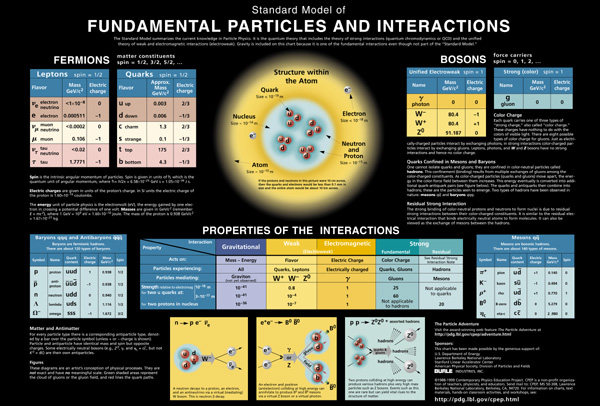
This is a clickable map; click on it to go directly to the enlargement
for any part of the chart.
The Standard Model summarizes the current knowledge
in Particle Physics. It is the quantum theory that includes the
theory of strong interactions
(quantum chromodynamics or QCD) and the unified theory of
weak and electromagnetic interactions (electroweak).
Gravity is included on this chart because it is one of the
fundamental interactions even though not part of the "Standard Model."
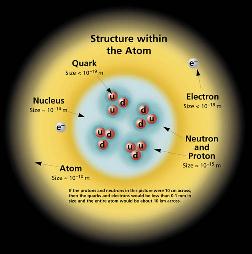
Larger
Huge
The text of the figure reads:
If the protons and neutrons in this picture were 10 cm across, then the
quarks and electrons would be less than 0.1 mm in size and the
entire atom would be about 10 km across.
Spin is the intrinsic
angular momentum of particles. Spin is given in units of h-bar,
which is the quantum unit of angular momentum, where
hbar=h/2pi = 6.58*10-25 GeV s = 1.05*10-34 J s.
Electric charges are given in units of the
proton's charge.
In SI units the electric charge of the proton is 1.60 * 10-19 coulombs.
The energy unit of
particle physics is the electron volt (eV),
the energy gained by one electron in
crossing a potential difference of one volt.
Masses are given in GeV/c2
(remember E = mc2),
where 1 GeV = 109 eV = 1.60 * 10-10 joule.
The mass of the proton is 0.938
GeV/c2 = 1.67*10-27 kg.
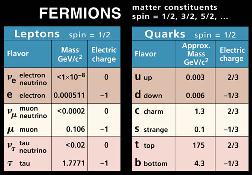
Larger
Huge
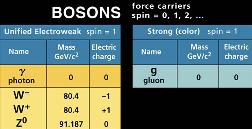
Larger
Huge
Color Charge
Each quark carries one of the three types of "strong charge,"
also called "color charge."
These charges have nothing to do with the colors of visible light.
There are eight possible types of color charge for gluons.
Just as electrically-charged particles interact by exchanging photons,
in strong interactions color-charged particles interact by exchanging gluons.
Leptons, photons, and W and Z bosons
have no strong interaction and hence no color charge.
Quarks Confined in Mesons and Baryons
One cannot isolate quarks and gluons;
they are confined in color-neutral particles called hadrons.
This confinement (binding) results from
multiple exchanges of gluons among the color-charged constituents.
As color-charged particles (quarks and gluons) move apart,
the energy in the color force between them
increases.
This energy eventually is converted into additional
quark-antiquark pairs (see
figure below).
The quarks and antiquarks then combine into hadrons; these are the
particles seen to emerge. Two types of hadrons have been
observed in nature:
mesons q qbar and baryons qqq.
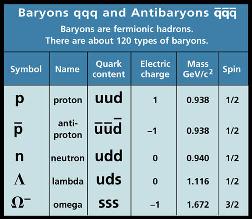
Larger
Huge
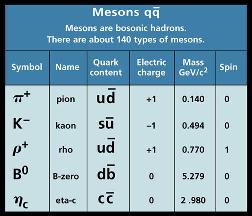
Larger
Huge
Residual Strong Interactions
The strong binding of color-neutral protons and neutrons to
form nuclei is due to residual strong interactions
between their color-charged constituents.
It is similar to the residual electrical interaction
which binds electrically neutral atoms to form molecules.
It can also be viewed as the exchange of mesons between the hadrons.
Properties of the Interactions

Larger
Huge
Matter and Antimatter
For every particle type there is a corresponding antiparticle type,
denoted by a bar over the particle symbol (unless + or 0
charge is shown). Particle and antiparticle
have identical mass and spin but opposite charges. Some
electrically neutral bosons
(e.g, Z0,
gamma, and eta_c = c cbar, but not
K0 = dsbar) are their own antiparticles.
Figures
These diagrams are an artist's conception of physical processes.
They are not exact and have no meaningful scale.
Green shaded areas represent the cloud of gluons or the gluon field,
and red lines the quark paths.
Charts
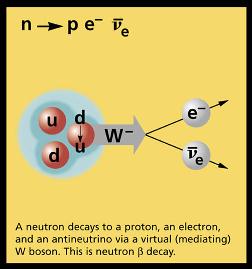
Larger
Huge
The text of the figure reads:
A neutron decays to a proton,
an electron, and an antineutrino via a virtual (mediating) W
boson. This is neutron beta decay.
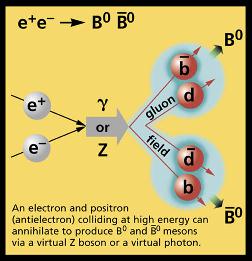
Larger
Huge
The text of the figure reads:
An electron and positron (antielectron)
colliding at high energy can annihilate to
produce
B0 and Bbar0
mesons via a virtual Z boson or a virtual photon.
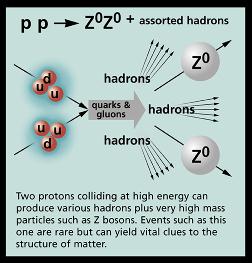
Larger
Huge
The text of the figure reads:
Two protons colliding at high energy can
produce various hadrons plus very high mass particles such as Z
bosons. Events such as this one are rare but can yield vital clues to the
structure of matter.
The Particle Adventure
Visit the award-winning web feature The Particle Adventure
at
http://pdg.lbl.gov/cpep.html.
Sponsors:
This chart has been made possilbe by the generous support of:
-
U.S. Department of Energy
-
Lawrence Berkeley National Laboratory
-
Stanford Linear Accelerator Center
- American Physical Society, Division of Particles and Fields
-
BURLE Electron Tubes
Copyright in 1988-1999 Contemporary Physics Education
Project. CPEP is a non-profit organization of
teachers, physicists, and educators. Send mail to:
CPEP, MS 50-308, Lawrence Berkeley
National Laboratory, Berkeley, CA 94720, USA.
For information on charts, text materials, hands-on classroom
activites, and workshops, see:
http://pdg.lbl.gov/cpep.html.


![]()
![]()
![]()
![]()